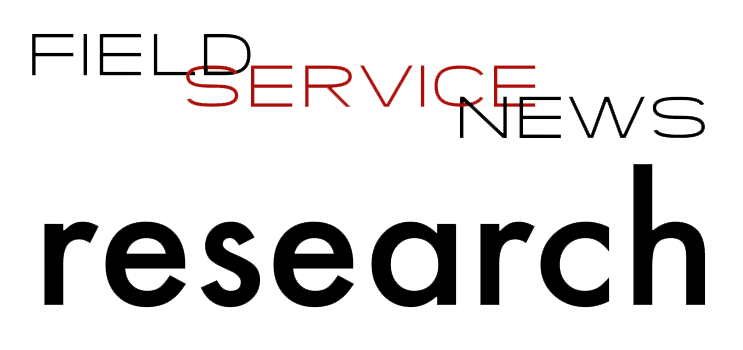The Tools And Processes Being Used For Workforce Management
As we continue the analysis our exclusive research study run in conjunction with specialist workforce management solution provider Goodt, we explore the tools being used by service-centric companies for workforce management...
Having explored a number of the critical best-practices and trends within workforce management amongst field service organizations as well as the broader umbrella of service-centric sectors at large, let us now take a look at what processes are being used within workforce management in general and the tools that are in place to drive those processes.
To begin, let us look at how the companies within our response set tackle resource demand calculations. We asked the study respondents to outline which of the following was closest to their approach for calculating resource demand?
- Expertly based on the sales plan (the relevant director receives a monthly sales plan and assigns people expertly based on experience)
- Repeating schedules with fixed sequences of shifts (demand and load are not taken into account in any way - and the plan is based according to template schedules)
- Based on basic forecasts for the day (moving average), the monthly plan is broken - based on this information; the director manually arranges shifts – trying to bring more people out on those days where peaks are expected (morning/evening are not taken into account because the forecast is at the day level) - shifts are also mostly cyclical, but individual shift shifts are simply added in the cycle under the peak.
- Based on the forecast of turnover growth for a month – turnover growth is converted into the number of available people/hours per month that are available for placement.
The split across these four options was particularly interesting and outlines that there appears to be no one stand out approach when it comes to calculating resource demand. The respondents to the study showed that three of these options were equally shared, each selected by 30% of our respondents. The anomaly was the second option in our list (repeating schedules with fixed sequences of shifts), listed by just 10% of respondents. (figure. 5)

This would suggest two areas for consideration for the majority of service based organizations. Firstly, it indicates that the majority of service-centric organizations face a variable demand for workforce capacity.
The second takeaway here is that it appears that consensus is broadly split as to which approach is best and could potentially be driven by the planning tools at hand as each of the three methods is based around the interpretation of different sets of data.
However, in the first option on this list, there could be an over-reliance on individual expertise. On the other hand, the other two options rely on forecast data that can be open to inaccuracies. As we begin to look at the tools most widely used for such planning, the potential for such inaccuracies to become costly errors would seem to be magnified.
We asked our respondents which tools they used within their workforce planning systems. While there were some dedicated workforce management planning applications referenced alongside some Field Service Management solutions that also have capacity planning incorporated within them (solutions referenced were Kronos, Oracle, Service Manager, Tableau Power BI, Salesforce, and ServiceMax), the overwhelming majority of companies were still reliant on Excel.
While in the hands of experts, it truly is incredible just what can be achieved with Excel in terms of resource planning, it really should be deemed a legacy approach to workforce management in 2021. It is labour intensive to import data, reliant upon and thus capable of magnifying errors in forecasting. It is notoriously difficult to make changes efficiently and dynamically, as is often required by workforce management processes.
Across the field service sector, we have seen a massive spike in investments within digital transformation. As we have seen earlier in this report, effective workforce management can positively impact both ends of the P&L regarding cost reduction and revenue generation. Therefore, it would seem that a large percentage of service-focused organizations could achieve an impressive Return on Investment quite swiftly if they were to invest in a modern, fit-for-purpose workforce management tool.
Similarly, many such tools also offer companies the ability to introduce gamification elements into their workforce management processes.
Gamification has been proven in many ways within the field service sector, from regional team performance to improving driver behaviour. When it comes to workforce management, gamification can enable employees to earn rewards or recognition for hitting KPIs.
Gamification programs that prove successful are based on the fundamental principle that people are motivated by different things. For example, some employees may enjoy competition with their peers. In contrast, others may prefer to compete only against themselves – seeking to improve their performance day after day or week to week, etc.
Therefore, to successfully motivate and engage people, gamification programs must incorporate a wide variety of competitive and non-competitive challenges and tangible and intangible rewards. To achieve this, a level of automation and utilization of fit-for-purpose application is recommended. Still, once again, the return on investment that such tools can yield can be significant when measured against the team’s increased productivity, be it in the back-office, the field, warehouse or store.
However, the study reveals that when it comes to workforce management, the introduction of gamification into the workforce management system remains a best-in-class solution, with only 16% of companies stating that they have any form of gamification within their workforce management processes (figure 6).
 Interestingly, when we cross-reference the data around gamification with companies with lower employee churn, we see that those organizations utilizing gamification are 25% more likely to have an employee churn lower than the industry average. Further to this, as a follow-up question to the small group of companies who utilize gamification in their workforce management processes, we asked them if they had found that gamification had improved productivity. 100% of respondents answered this question in the affirmative.
Interestingly, when we cross-reference the data around gamification with companies with lower employee churn, we see that those organizations utilizing gamification are 25% more likely to have an employee churn lower than the industry average. Further to this, as a follow-up question to the small group of companies who utilize gamification in their workforce management processes, we asked them if they had found that gamification had improved productivity. 100% of respondents answered this question in the affirmative.
With this in mind, the case for those companies still using Excel spreadsheets to manage their workforce management and resource planning to bite the bullet and adopt a modern workforce management solution seems compelling indeed.
 If you are a Field Service News subscriber on either our free-forever FSN Standard subscription tier or our Premium Subscription tier you can access a 15 page report written by Field Service News, Editor-in-Chief, Kris Oldland that offers in-depth analysis of the research project now on the button below.
If you are a Field Service News subscriber on either our free-forever FSN Standard subscription tier or our Premium Subscription tier you can access a 15 page report written by Field Service News, Editor-in-Chief, Kris Oldland that offers in-depth analysis of the research project now on the button below.
If you are not yet a subscriber to Field Service News but would like to subscribe and gain access to this report instantly, click the button to be visit a dedicated registration page for our complimentary sponsored subscription tier and that will give you instant access to this paper and a number of other assets currently available to subscribers on this tier.
 Data usage note: By accessing this content you consent to the contact details submitted when you registered as a subscriber to fieldservicenews.com to be shared with the listed sponsor of this premium content, SoS on behalf of Goodt, who may contact you for legitimate business reasons to discuss the content of this report.
Data usage note: By accessing this content you consent to the contact details submitted when you registered as a subscriber to fieldservicenews.com to be shared with the listed sponsor of this premium content, SoS on behalf of Goodt, who may contact you for legitimate business reasons to discuss the content of this report.
Employee Placement, Discipline and Churn
Employee Engagement and Staff Loyalty
Written by Kris Oldland
Kris Oldland has been working in Business to Business Publishing for almost a decade. As a journalist he has covered a diverse range of industries from Fire Juggling through to Terrorism Insurance. Prior to this he was a Quality Services Manager with a globally recognised hospitality brand. An intimate understanding of what is important when it comes to Service and a passion for emerging technology means that in Field Service he has found an industry that excites him everyday.


